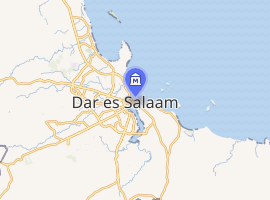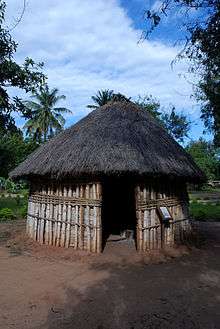National Museum of Tanzania
The National Museum of Tanzania is a consortium of five Tanzanian museums whose purpose is to preserve and show exhibits about the history and natural environment of Tanzania. The consortium developed from the National Museum of Dar es Salaam, established in 1934 by Tanganyika governor Harold MacMichael. Four more museums later joined the consortium, namely the Village Museum in Dar es Salaam, the National History Museum and the Arusha Declaration Museum in Arusha, and the Mwalimu Julius K. Nyerere Memorial Museum in Butiama.
The National Museum entrance. | |

| |
| Established | 1934 |
|---|---|
| Collections | history and natural environment of Tanzania |
| Founder | Tanganyika governor Harold MacMichael. |
| Executive Director | Professor Audax Mabula |
| Website | www |
Dar es Salaam National Museum
The Dar es Salaam National Museum is located in Shabban Robert Street, next to the botanical gardens. Established in 1934 and open to the public since 1940,[1] it was originally a memorial museum dedicated to King George V; one of the cars of the King is still on display. The museum was expanded in 1963, with the addition of a second building. It is now dedicated to the history of Tanzania. Its most famous exhibits include some bones of Paranthropus boisei that were among the findings of Louis Leakey at Olduvai. The museum also has a large section dedicated to the Shirazi city-state of Kilwa. More historical miscellaneous material is related to the German and British rule, and ancient Chinese pottery.[2] The museum also has ethnographic collections on Tanzanian cultures.
Village Museum

The Kijiji cha Makumbusho, or Village Museum, established in 1967,[3] is an open-air ethnographical museum located in the outskirts of Dar es Salaam, on the road to Mwenge and Bagamoyo. It showcases traditional huts from 16 different Tanzanian ethnic groups. There are also examples of traditional cultivations, and traditional music and dance shows are held daily.[4]
National Natural History Museum
The National Natural History Museum in Arusha, open since 1987, is located in Arusha, in Boma Road. It has two permanent exhibits, respectively on human evolution and entomology.[5]
Arusha Declaration Museum
The Arusha Declaration Museum, open since 1977, is located in Arusha, in Kaloleni Road. It displays documents on the colonial history of Tanzania, the fight for independence, and the Arusha Declaration where the first Tanzanian president Julius Nyerere outlined his political vision.[6]
Nyerere Museum
The Mwalimu[7] Julius K. Nyerere Memorial Museum, or Nyerere Museum for short, was established in the year 1999. It is located in Butiama, where Tanzania's first president Julius Nyerere was born and was buried. The museum display items related to Nyerere's personal and political life.[8]
See also
External links
Footnotes
- "12 Top-Rated Tourist Attractions in Dar es Salaam - PlanetWare".
- "12 Top-Rated Tourist Attractions in Dar es Salaam - PlanetWare".
- Richard Wood (2001-01-01). "The village museum, Dar es Salaam". Tanzanian Affairs (68). Retrieved 2017-03-03.
- "Archived copy". Archived from the original on 2011-08-11. Retrieved 2010-10-26.CS1 maint: archived copy as title (link)
- "Archived copy". Archived from the original on 2011-10-08. Retrieved 2010-10-26.CS1 maint: archived copy as title (link)
- "Archived copy". Archived from the original on 2011-10-09. Retrieved 2010-10-26.CS1 maint: archived copy as title (link)
- "Mwalimu" is the swahili word for "teacher", a common epithet for President Julius Nyerere.
- "Archived copy". Archived from the original on 2011-10-09. Retrieved 2010-10-26.CS1 maint: archived copy as title (link)
- http://www.nmt.go.tz